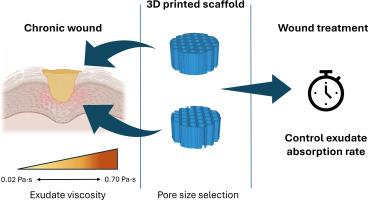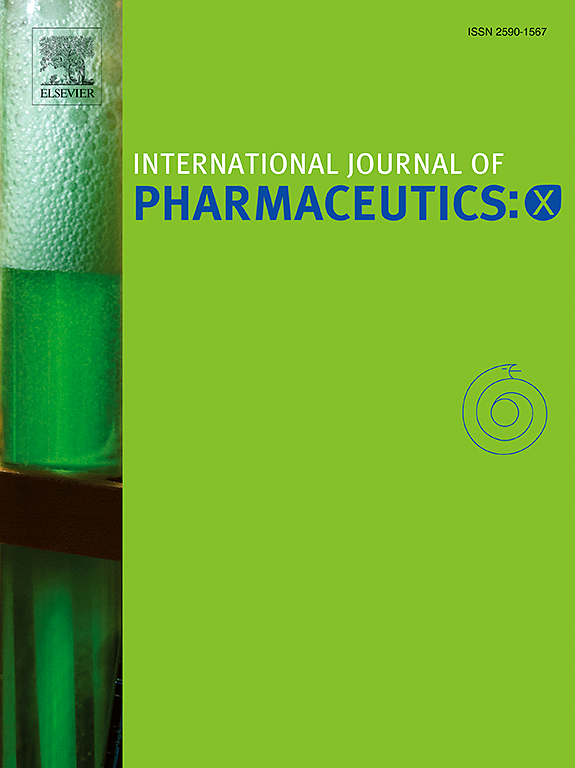伤口敷料孔隙率和渗出物粘度对渗出物吸收的影响:三维打印水凝胶的体外和体内测试
IF 5.2
2区 医学
Q1 PHARMACOLOGY & PHARMACY
引用次数: 0
摘要
渗出物吸收是伤口敷料性能是否正常的一个关键参数。标准化测试认为渗出液的粘度接近于水的粘度,但患者的渗出液成分差异很大,因此粘度也不尽相同。这项工作旨在研究渗出液粘度和水凝胶类敷料的孔径对渗出液吸收率的影响,从而为敷料的设计建立合理的标准,满足伤口治疗的个性化需求。计算机辅助设计(CAD)用于数字光处理(DLP)三维打印孔隙率为 0%、30% 和 60% 的水凝胶。对水凝胶进行了详细表征,并对两种模拟渗出液(SEF)的吸收情况进行了视频记录。同样的 CAD 文件被用于开发模拟渗出液吸收率的硅学模型。体外数据和硅学模型均显示,由于毛细力的作用,低粘度 SEF 穿过相对较小的水凝胶孔隙(约 400 μm)的速度比穿过较大孔隙(约 1100 μm)的速度快。不过,体外垂直吸收所需的时间比使用 CAD 设计模拟的时间要长,这是因为液体通过水凝胶体中的孔壁被横向吸收。在对 SEF 的渗透进行硅模拟时,应同时考虑水凝胶通道的扭曲(显微 CT 图像)和横向流体吸收。总之,研究结果表明,多孔水凝胶敷料可以快速渗透(几秒钟内)并容纳渗出液,尤其是在孔径为 1 毫米的情况下。这些信息可能有助于制定具有足够液体处理能力和药物释放率的伤口敷料的设计标准。本文章由计算机程序翻译,如有差异,请以英文原文为准。

Effect of wound dressing porosity and exudate viscosity on the exudate absorption: In vitro and in silico tests with 3D printed hydrogels
Exudate absorption is a key parameter for proper wound dressing performance. Unlike standardized tests that consider exudate viscosity close to that of water, patients' exudates vary greatly in composition and, therefore, viscosity. This work aimed to investigate the effects of exudate viscosity and pore size of hydrogel-like dressings on the exudate absorption rate to establish rational criteria for the design of dressings that can meet the personalized needs of wound treatment. Computer-aided design (CAD) was used for Digital Light Processing (DLP) 3D printing of hydrogels with 0%, 30% and 60% porosity. The hydrogels were characterized in detail, and the absorption of two simulated exudate fluids (SEFs) was video-recorded. The same CAD files were used to develop in silico models to simulate exudate uptake rate. Both in vitro data and in silico modeling revealed that low-viscosity SEF penetrates faster through relatively small hydrogel pores (approx. 400 μm) compared to larger pores (approx. 1100 μm) due to capillary forces. However, in vitro vertical uptake took longer than when simulated using CAD design due to lateral fluid absorption through the pore walls in the hydrogel bulk. Distortions of hydrogel channels (micro-CT images) and lateral fluid absorption should be both considered for in silico simulation of SEF penetration. Overall, the results evidenced that porous hydrogel dressings allow rapid penetration (within a few seconds) and hosting of exudates, especially for pore size <1 mm. This information may be useful for design criteria of wound dressings with adequate fluid handling and drug release rate.
求助全文
通过发布文献求助,成功后即可免费获取论文全文。
去求助
来源期刊

International Journal of Pharmaceutics: X
Pharmacology, Toxicology and Pharmaceutics-Pharmaceutical Science
CiteScore
6.60
自引率
0.00%
发文量
32
审稿时长
24 days
期刊介绍:
International Journal of Pharmaceutics: X offers authors with high-quality research who want to publish in a gold open access journal the opportunity to make their work immediately, permanently, and freely accessible.
International Journal of Pharmaceutics: X authors will pay an article publishing charge (APC), have a choice of license options, and retain copyright. Please check the APC here. The journal is indexed in SCOPUS, PUBMED, PMC and DOAJ.
The International Journal of Pharmaceutics is the second most cited journal in the "Pharmacy & Pharmacology" category out of 358 journals, being the true home for pharmaceutical scientists concerned with the physical, chemical and biological properties of devices and delivery systems for drugs, vaccines and biologicals, including their design, manufacture and evaluation. This includes evaluation of the properties of drugs, excipients such as surfactants and polymers and novel materials. The journal has special sections on pharmaceutical nanotechnology and personalized medicines, and publishes research papers, reviews, commentaries and letters to the editor as well as special issues.
 求助内容:
求助内容: 应助结果提醒方式:
应助结果提醒方式:


